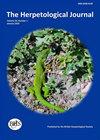形态评估提高了鲁里斯坦蝾螈中存在神秘物种的可能性,凯塞里蝾螈(两栖纲:蝾螈科)
IF 1.1
4区 生物学
Q3 ZOOLOGY
引用次数: 2
摘要
保护生物多样性的主要挑战之一是克服对物种及其特定内部多样性认识不足的问题。在本研究中,我们试图评估伊朗特有的鲁里斯坦蝾螈(Neurergus kaiseri,Schmidt 1952)中两个先前确定的遗传分支的形态差异,这对其保护计划至关重要。使用基于标志的身体形状和骨结构特征的几何形态计量学来评估凯塞里猪笼草的形态变化信号。形态学方法揭示了物种内部的一致分组,证实了两个不同谱系的存在(以前被命名为北部和南部分支)。形态学和遗传学数据为凯塞里猪笼草中两个物种可能共存提供了证据,我们建议将新识别的形态分配到物种水平。本文章由计算机程序翻译,如有差异,请以英文原文为准。
Morphological assessment raises the possibility of cryptic species within the Luristan newt, Neurergus kaiseri (Amphibia: Salamandridae)
One of the main challenges in the conservation of biodiversity is to overcome inadequate knowledge about species and their intra-specific diversity. In the present study, we attempted to assess morphological distinction of the two previously identified genetic clades within the Luristan newt (Neurergus kaiseri, Schmidt 1952) endemic to Iran, which is essential for its conservation planning. Signals of the morphological variation in N. kaiseri were evaluated using landmark-based geometric morphometrics of body shape and characters of osteological structures. Morphological approaches revealed consistent groupings within the species, confirming the presence of two distinct lineages (previously named as the northern and southern clades). The morphological and genetic data provide evidence for the possible co-existence of two species in N. kaiseri and we recommend assigning the newly recognised forms to the species level.
求助全文
通过发布文献求助,成功后即可免费获取论文全文。
去求助
来源期刊

Herpetological Journal
生物-动物学
CiteScore
2.40
自引率
10.00%
发文量
25
审稿时长
>12 weeks
期刊介绍:
The Herpetological Journal is the Society''s prestigious quarterly scientific journal.
 求助内容:
求助内容: 应助结果提醒方式:
应助结果提醒方式:


